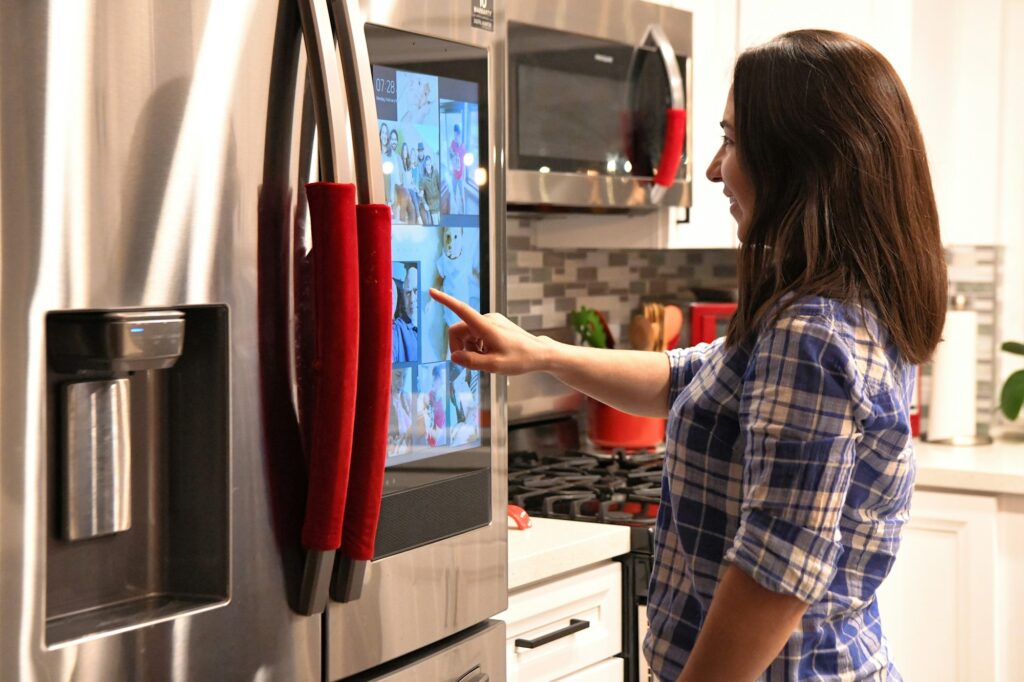The evolution of smart home technology has revolutionized the way we live, offering convenience, security, and efficiency. Among the many innovations in this field, voice-controlled kitchen appliances stand out as a significant step forward in modernizing our homes. These appliances, which can be controlled through voice commands, represent the next generation of home automation, making daily tasks in the kitchen easier and more enjoyable.
In this article, we will explore the evolution of smart homes, the benefits of voice-controlled kitchen appliances, their key features, challenges, and the future outlook. We will delve into how these appliances have evolved from early smart home technologies to the integration of virtual assistants like Amazon Alexa and Google Assistant. We will also discuss the convenience and time-saving benefits of voice-controlled appliances, their accessibility for people with disabilities, and their energy efficiency.
Additionally, we will examine the key features that make voice-controlled kitchen appliances unique, such as voice recognition technology, integration with virtual assistants, and connectivity with other smart home devices. We will also address the challenges and considerations associated with these appliances, such as privacy and security concerns, compatibility issues with older appliances, and reliability.
Finally, we will explore the future of voice-controlled kitchen appliances, including advancements in technology, potential for broader integration, and consumer adoption and market growth. We will conclude by summarizing the benefits and challenges of voice-controlled appliances and offering our predictions for their impact on the kitchen and smart home industry.
The Evolution of Smart Homes

A. Early Smart Home Technologies
The concept of a smart home has been around for decades, but early smart home technologies were limited in scope and functionality. Programmable thermostats, introduced in the 1970s, were among the first smart home devices. These thermostats allowed homeowners to set a schedule for their heating and cooling systems, enabling them to save energy and reduce utility bills.
Security systems were another early smart home technology. In the 1980s, companies began offering home security systems that could be monitored remotely. These systems allowed homeowners to keep an eye on their homes while they were away, providing peace of mind and enhancing security.
B. The Emergence of Voice-Controlled Systems
The emergence of voice-controlled systems has been a major development in the evolution of smart homes. These systems use natural language processing to understand and respond to voice commands, allowing users to control various devices in their homes using simple voice commands.
The first voice-controlled system was introduced in the 1990s. This system, known as the “Speak & Spell,” allowed users to control various devices in their home using voice commands. However, the technology was limited in functionality and was not widely adopted.
C. Integration of Virtual Assistants
The integration of virtual assistants like Amazon Alexa and Google Assistant has been a significant development in the evolution of smart homes. These assistants can be used to control a wide range of devices in the home, including voice-controlled kitchen appliances.
Virtual assistants work by using natural language processing to understand and respond to voice commands. This allows users to control their appliances using voice commands, even when they are not in the same room as the appliance.
Overall, the evolution of smart homes has been a gradual process, with early technologies laying the foundation for the modern smart home. The emergence of voice-controlled systems and the integration of virtual assistants have been major developments, making it easier for homeowners to create a smart home that is truly tailored to their needs.
The Benefits of Voice-Controlled Kitchen Appliances
A. Convenience and Time-Saving
Voice-controlled kitchen appliances offer unparalleled convenience in the kitchen. By simply speaking a command, users can control various functions of their appliances without having to physically interact with them. This is particularly advantageous when multitasking or when hands are occupied with other tasks.
For example, while preparing a meal, a user can ask their voice-controlled oven to preheat to a specific temperature or set a timer without having to pause their cooking. This seamless interaction streamlines the cooking process and reduces the need to constantly check or adjust settings manually.
Moreover, voice commands can be used to control multiple appliances simultaneously, allowing for a more efficient and coordinated cooking experience. For instance, a user can instruct their voice-controlled oven to start baking while simultaneously activating the microwave to defrost ingredients, all without leaving their current task.
B. Accessibility for People with Disabilities
Voice-controlled kitchen appliances are also highly accessible for individuals with disabilities. For those with limited mobility or dexterity, interacting with traditional appliances can be challenging. Voice control eliminates the need for physical interaction, enabling individuals to control their appliances independently.
This accessibility extends beyond physical disabilities to include cognitive impairments or language barriers. Simplified voice commands make it easier for users to operate appliances, regardless of their level of technological proficiency. This inclusive design philosophy ensures that voice-controlled kitchen appliances can be enjoyed by a wide range of users.
C. Energy Efficiency and Cost Savings
Voice-controlled kitchen appliances contribute to energy efficiency and cost savings. Precise control over appliance settings ensures that energy is used more effectively, reducing wastage and lowering utility bills. For example, a user can instruct their voice-controlled oven to preheat only when needed, preventing unnecessary energy consumption.
Additionally, voice-controlled appliances often come equipped with energy-saving features, such as sensors that detect when a room is empty and adjust settings accordingly. This proactive approach to energy management not only reduces environmental impact but also helps users save money over time.
In summary, voice-controlled kitchen appliances offer a range of benefits, including convenience, accessibility, energy efficiency, and cost savings. These devices are revolutionizing the way we interact with our kitchens, making cooking and baking more efficient, accessible, and enjoyable.
Key Features of Voice-Controlled Kitchen Appliances
A. Voice Recognition Technology
Voice recognition technology is the cornerstone of voice-controlled kitchen appliances. These devices are equipped with advanced microphones and software that can accurately interpret and respond to human speech. This technology enables users to interact with their appliances using natural language, making the experience more intuitive and user-friendly.
B. Integration with Virtual Assistants
Voice-controlled kitchen appliances are often designed to integrate seamlessly with virtual assistants like Amazon Alexa or Google Assistant. This integration allows users to control their appliances using voice commands, even when they are not in the same room. For example, a user can ask their virtual assistant to preheat the oven while they are in the living room, and the oven will start heating up without any further action required.
C. Connectivity with Other Smart Home Devices
Voice-controlled kitchen appliances are also designed to be compatible with other smart home devices, allowing for a more integrated and connected home. For example, a user can set up a routine that turns on the lights, starts the coffee maker, and preheats the oven when they wake up in the morning, all with a single voice command.
Additionally, voice-controlled kitchen appliances often come equipped with sensors that can detect when a room is empty or when the appliance is not in use. This allows the appliance to automatically adjust its settings to conserve energy and reduce utility bills.
In summary, voice-controlled kitchen appliances offer a range of key features, including voice recognition technology, integration with virtual assistants, and connectivity with other smart home devices. These features make these appliances more user-friendly, efficient, and convenient, enhancing the overall smart home experience.
Challenges and Considerations
A. Privacy and Security Concerns
One of the primary concerns with voice-controlled kitchen appliances is privacy and security. These devices are constantly listening for voice commands, which raises concerns about the potential for unintended recordings of private conversations. Manufacturers have implemented various privacy features, such as the ability to mute the microphone when not in use, but these concerns remain.
Additionally, voice-controlled appliances are connected to the internet, which opens up the possibility of hacking or unauthorized access. Manufacturers must prioritize security measures to protect user data and ensure the safety of their devices.
B. Compatibility Issues with Older Appliances
Another challenge with voice-controlled kitchen appliances is compatibility with older appliances. While many newer appliances are designed to be compatible with voice-controlled technology, older appliances may not be. This can make it difficult for homeowners to fully integrate their kitchen into their smart home system.
C. Reliability and Potential for Errors
Finally, there is the issue of reliability. While voice-controlled technology has come a long way in recent years, it is still not perfect. There is always a risk that the device will not understand a command correctly or will not respond at all. This can be frustrating for users, especially if they are in the middle of cooking a meal.
In summary, voice-controlled kitchen appliances offer many benefits, but there are also some challenges and considerations to keep in mind. Privacy and security concerns, compatibility issues with older appliances, and reliability are all factors that should be considered when deciding whether to invest in these devices.
The Future of Voice-Controlled Kitchen Appliances
A. Advancements in Technology
As technology continues to advance, we can expect to see even more sophisticated features and capabilities in voice-controlled kitchen appliances. For example, voice recognition technology is constantly improving, making it more accurate and reliable. This will lead to a more seamless and intuitive user experience.
B. Potential for Broader Integration
Voice-controlled kitchen appliances are likely to become even more integrated with other smart home devices. This will allow for a more cohesive and interconnected smart home experience. For example, a user could set up a routine that turns on the lights, starts the coffee maker, and preheats the oven when they wake up in the morning, all with a single voice command.
C. Consumer Adoption and Market Growth
As the benefits of voice-controlled kitchen appliances become more widely known, we can expect to see increased consumer adoption and market growth. This will lead to more competition among manufacturers, which will drive innovation and result in even better products for consumers.
In summary, the future of voice-controlled kitchen appliances looks bright. As technology continues to improve, these devices will become more accurate, reliable, and easy to use. This will make it easier for homeowners to create a smart home that is truly tailored to their needs.
Also Read: Voice-Controlled Smart Speakers: Beyond Basic Commands
Conclusion
Voice-controlled kitchen appliances offer a range of benefits, including convenience, accessibility, energy efficiency, and cost savings. These devices are revolutionizing the way we interact with our kitchens, making cooking and baking more efficient, accessible, and enjoyable. As technology continues to advance, we can expect to see even more sophisticated features and capabilities in voice-controlled kitchen appliances. This will lead to a more seamless and intuitive user experience, as well as increased consumer adoption and market growth. Voice-controlled kitchen appliances are an integral part of the modern smart home, and their future looks bright.
